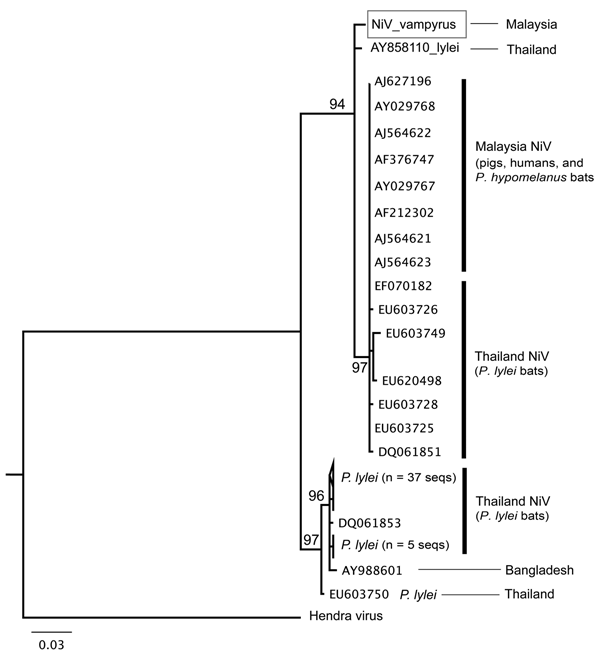Characterization of Nipah Virus from Naturally Infected Pteropus vampyrus Bats, Malaysia
Sohayati A. Rahman

, Sharifah S. Hassan, Kevin J. Olival, Maizan Mohamed, Li-Yen Chang, Latiffah Hassan, Norsharina M. Saad, Syamsiah A. Shohaimi, Zaini C. Mamat, M.S. Naim, Jonathan H. Epstein, Arshad S. Suri, Hume E. Field, Peter Daszak, and the Henipavirus Ecology Research Group
Author affiliations: Author affiliations: Veterinary Research Institute, Ipoh, Malaysia (S.A. Rahman, S.A. Shohaimi, Z.C. Mamat, M.S. Naim); Monash University, Selangor, Malaysia (S.S. Hassan); EcoHealth Alliance, New York, New York, USA (K.J. Olival, J.H. Epstein, P. Daszak); University of Science Malaysia, Kelantan, Malaysia (M. Mohamed); University of Malaya, Kuala Lumpur, Malaysia (L.-Y. Chang); University Putra Malaysia, Serdang, Selangor (L. Hassan, A.S. Suri); Ministry of Science, Technology and Innovation, Putrajaya, Malaysia (N.M. Saad); Queensland Primary Industries and Fisheries, Moorooka, Queensland, Australia (H.E. Field)
Main Article
Figure 2

Figure 2. Partial nucleocapsid gene (358 bp) maximum-likelihood tree for all available Nipah virus (NiV) sequences (seqs) in GenBank, showing a high level of NiV sequence diversity in Pteropus lylei bat isolates from Thailand. NiV P. vampyrus (box) is most closely related to AY858110 from P. lylei bats and forms a large clade that includes other P. lylei bat isolates and all NiV sequences from Malaysia. GenBank accession numbers are given for NiV isolates from pigs in Malaysia (AJ627196, Tambun; AJ564621, Sg. Buloh; and AJ564622, Seremban), humans in Malaysia (AJ564623, AF212302, AY029767, and AY029768), humans in Bangladesh (AY988601), P. hypomelanus bats in Malaysia (AF376747), P. lylei bats in Cambodia (nucleocapsid gene-AY858110, DQ061851–58, EF070182–90, EU603724–58, EU620498, and EU624735–37), and Hendra virus from Australia (AF017149). Scale bar indicates nucleotide substitutions per site.
Main Article
Page created: August 28, 2011
Page updated: August 28, 2011
Page reviewed: August 28, 2011
The conclusions, findings, and opinions expressed by authors contributing to this journal do not necessarily reflect the official position of the U.S. Department of Health and Human Services, the Public Health Service, the Centers for Disease Control and Prevention, or the authors' affiliated institutions. Use of trade names is for identification only and does not imply endorsement by any of the groups named above.
